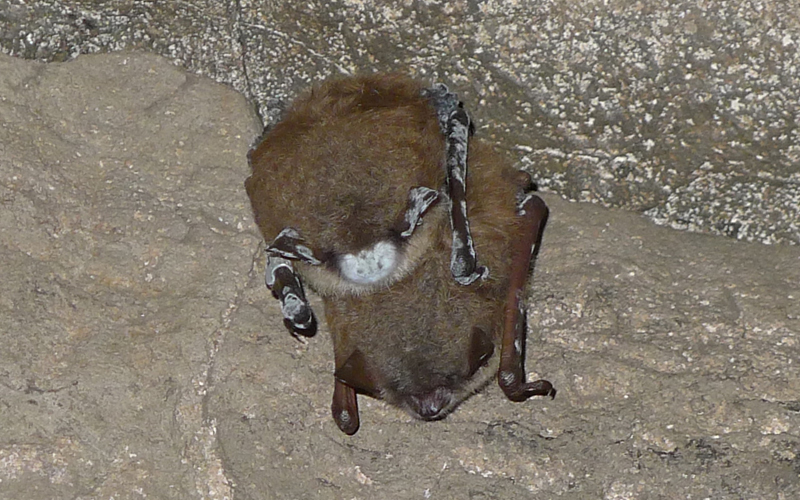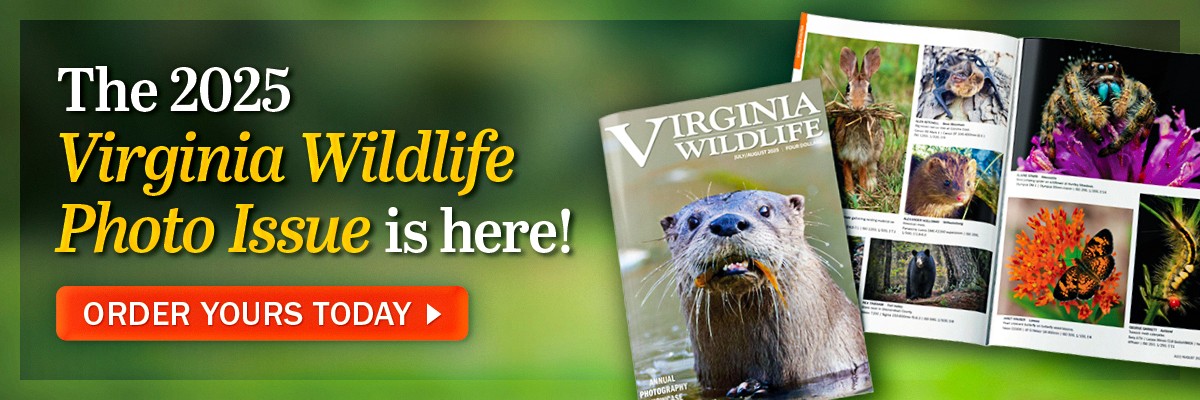በሞሊ ኪርክ/DWR
ፎቶዎች በሪክ ሬይኖልድስ/DWR
በቨርጂኒያ ውስጥ ነጭ-አፍንጫ ሲንድረም ከተገኘበት ጊዜ ጀምሮ በቨርጂኒያ ውስጥ ለሚኖሩ የሌሊት ወፎች ብዙ መልካም ዜና አልተገኘም 90 2009 እና በመጥፋት ላይ ያሉ ዝርያዎች ህግ (ESA) የሌሊት ወፎችን ከነጭ-አፍንጫ ሲንድረም መከላከል ባይችልም፣ ESA ጥበቃዎች የሌሊት ወፍ ህዝቦችን በሌሎች መንገዶች ረድቷቸዋል ይህም የቨርጂኒያ ልዩ ልዩ የዱር አራዊት ስብስብ አካል ሆነው እንዲቀጥሉ አስችሏቸዋል፣ ምንም እንኳን ነጭ አፍንጫ ቁጥራቸውን እያጠፋ ነው።
የቨርጂኒያ የዱር አራዊት ሃብቶች ዲፓርትመንት (DWR) ያልሆኑ ጌም ባዮሎጂስት የሆኑት ሪክ ሬይኖልድስ “ESA ለእነዚህ ዝርያዎች ከፍተኛ መገለጫ ይሰጣል፣ ስለዚህ እንደ ነጭ አፍንጫ ያሉ በዓይነቶቹ ላይ ተጽዕኖ እያሳደሩ ያሉትን እንደ ነጭ አፍንጫ ያሉ ጉዳዮችን ለመፍታት በመሞከር ላይ የበለጠ ትኩረት ይደረጋል” ብለዋል። “በዚያ ብዙ ጥረት አለ፣ እና ሳይንቲስቶች ነጭ-አፍንጫ ከፍተኛ ተጽዕኖ በሚያሳድርበት የሌሊት ወፍ በእንቅልፍ ጊዜ ውስጥ እንዲያልፍ ለመርዳት በአንዳንድ ዘዴዎች ላይ እድገት እያደረጉ ነው። በሌሊት ወፍ ላይ ብቻ ሳይሆን በመኖሪያ አካባቢም የተለያዩ የሕክምና ዓይነቶችን ይመለከታሉ። ተጨማሪ ግብዓቶች የበጋ ቅኝ ግዛቶችን ለመርዳት፣ በእነዚያ ጣቢያዎች ከአስተዳደር እና ጥበቃ ጋር ይመራሉ።

ነጭ-አፍንጫ ሲንድረም፣ በዚህች ትንሽ ቡናማ የሌሊት ወፍ አፍንጫ እና ክንፎች ላይ እንደሚታየው በሺዎች የሚቆጠሩ የሌሊት ወፎችን የሚገድል መሠሪ በሽታ ነው። ፎቶ በሪክ ሬይናልድስ/DWR
ነጭ-አፍንጫ ሲንድረም (WNS) በፈንገስ Pseudogymnoascus destructans ወይም Pd በአጭሩ. ፒዲ በ 40-50 ዲግሪዎች እና ከፍተኛ የእርጥበት መጠን መካከል ባለው የሙቀት መጠን ያድጋል—ተመሳሳይ የሙቀት ቅልመት እና የእርጥበት መጠን በዋሻዎች ውስጥ አብዛኞቹ የቨርጂኒያ የሌሊት ወፎች በእንቅልፍ ማደርን ይመርጣሉ። ፈንገስ ወደ የሌሊት ወፍ ጭራ ሽፋን፣ ክንፎች፣ ጆሮዎች እና አፈሙዝ ወደተጋለጠው ቆዳ (ቆዳ) ያድጋል። ፈንገስ ሁለቱም የሌሊት ወፎችን ያበሳጫቸዋል እና የውሃ ሚዛናቸውን ይረብሸዋል, ውሃ ያደርቃቸዋል. ይህም በእንቅልፍ ወቅት እንደወትሮው ሁለት ጊዜ ከእንቅልፍ እንዲነቁ ያደርጋቸዋል። ተጨማሪ እንቅስቃሴው የሚበሉ ነፍሳትን ለማግኘት ተጨማሪ ውድ ሃይል በመብረር የሌሊት ወፍ ማከማቻዎችን ያሟጥጣል። ተፅዕኖው ገዳይ ሊሆን ይችላል.
የቨርጂኒያ የሌሊት ወፎች ነጭ-አፍንጫ ሲንድረም እንዴት እንደሚተርፉ የበለጠ ያንብቡ ።
የቅድመ-ነጭ-አፍንጫ፣ የሌሊት ወፍ ዝርያዎች የመጀመሪያ ዝርዝር በፌዴራል ሊጠፉ የተቃረቡ እና ስጋት ላይ ያሉ ዝርያዎች ዝርዝር የመጣው በዋሻ hibernacula (የሚተኛባቸው ዋሻዎች) በእንቅልፍ ወቅት (በክረምት) በሰዎች ረብሻ ምክንያት የህዝብ ብዛት መቀነስ ነው። በESA የተቀመጡ ጥበቃዎች እና ስልቶች እነዚያን ስጋቶች ለመቀነስ ረድተዋል።
ሬይኖልድስ “ESA በመሠረቱ ገንዘቡን ሰጠን እና ለመጥፋት የተቃረቡ በርካታ ዝርያዎች ቀዳሚ hibernacula ለመለየት እና ከዚያም እነዚያን ቦታዎች ለመጠበቅ እድል ፈቅዶልናል፣ በመሬት ይዞታ ወይም በመሬት ባለቤትነት ትብብር ስምምነቶች” ብለዋል ሬይኖልድስ። በእንቅልፍ ጊዜ በእነዚያ ቦታዎች ላይ የሚፈጠረውን ረብሻ ለመቀነስ በሃይበርናኩላ ላይ የሌሊት ወፍ የሚመች በሮች ጫንን። ከሃያ ወይም 30 ዓመታት በፊት፣ በእንቅልፍ ወቅት የሚፈጠር ረብሻ የሌሊት ወፍ እና የእነሱ ውድቀትን በተመለከተ ዋናው ጉዳይ ነበር። የክረምቱን ሃይበርናኩላ እና የእነዚያን ጣቢያዎች ጥበቃን በተመለከተ ስጋት ላይ ባሉ እና አደጋ ላይ ባሉ የሌሊት ወፍ ዝርያዎች ላይ ጥሩ አያያዝ አግኝተናል።
ነጭ አፍንጫ በ' 90ሰከንድ ውስጥ ስለጀመረ በESA ስር የተሰራው የመኖሪያ እና የጥበቃ ስራ ለሌሊት ወፍ ጠቃሚ ነበር። በሌሎች ግዛቶች ያሉ ባዮሎጂስቶች በሁለቱም የሌሊት ወፎች እና መኖሪያዎቻቸው ውስጥ ነጭ-አፍንጫን ለማከም እየሰሩ ናቸው ፣ እና የቨርጂኒያ ባዮሎጂስቶች በነጭ-አፍንጫ ሲንድሮም ምላሽ ቡድን በኩል ስለ ሥራቸው መረጃ እየጠበቁ ናቸው። ይህ የምላሽ ቡድን ብሄራዊ እቅድ እና የስራ ቡድኖች አዘጋጅቷል። የቨርጂኒያ ጥረቶች በክትትል፣ በጥበቃ እና በማገገም ላይ ያተኮሩ ሲሆን እንዲሁም ለበሽታው ህክምና የሚያጠኑ ተመራማሪዎችን በመደገፍ ላይ ያተኮሩ ናቸው። በሕይወት የተረፉ ሰዎች የሚገኙበትን ቦታ መለየት እነሱን ለመጠበቅ እና ለማስተዳደር ቁልፍ ነው።
ሬይኖልድስ “ማየታችን የጀመርነው በነጭ-አፍንጫ ከሚጠቁ አንዳንድ ዝርያዎች ጋር የህዝብን ማረጋጋት ነው ብዬ አስባለሁ። “ከፈለግክ አንዳንድ የባህሪ ማሻሻያዎችን በማድረግ ራሳቸውን በመንከባከብ ላይ ናቸው። በኒውዮርክ ተመራማሪዎች በእንቅልፍ ወቅት የሚሄዱ ትንንሽ ቡናማ የሌሊት ወፎች ከቅድመ-ነጭ አፍንጫ የበለጠ ከነጭ አፍንጫ በኋላ ወፍራም እንደሆኑ ደርሰውበታል፣ በአንዳንድ ሁኔታዎች በአጠቃላይ በአንድ ሙሉ ግራም። እኔ እንደማስበው እነዚህ የሌሊት ወፎች የሰባው የሌሊት ወፍ በክረምቱ ወቅት የተሻለ እንደሚሆን እየተማሩ ነው። በቨርጂኒያ እና በሌሎች ግዛቶች የተመለከትናቸው ነገሮች የሌሊት ወፎች በእንቅልፍ ውስጥ የመግባት ገደቦችን የሚገፉ ይመስላል - በኋላ ወደ ዋሻዎቹ ለመግባት እና ከነጭ-አፍንጫው ቀድመው ለቀው ይወጣሉ። ፈንገስ በሕይወት ለመትረፍ ያ ቀዝቃዛና እርጥበት ያለው የዋሻ hibernacula የአየር ጠባይ ስለሚያስፈልገው የሌሊት ወፎች "በአካባቢው ውስጥ የሚያሳልፉትን ጊዜ በመገደብ ህመም እንዲሰማቸው ያደርጋል" ብለዋል ሬይኖልድስ።


